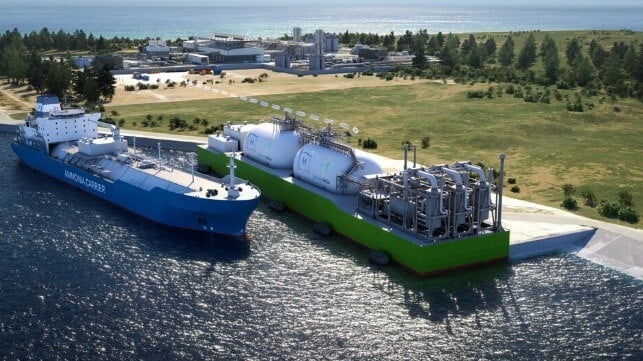First Floating Import Terminal with a Hydrogen Cracker Planned for Germany

Plans for the first floating terminal to handle the importation of hydrogen were announced as part of an effort to supply the alternative fuel to Germany’s industrial base. Deutsche ReGas and Hoegh-LNG, both of which helped Germany rapidly develop its LNG import terminals to replace Russian supplies, are teaming up to develop the new hydrogen facility.
The companies have signed an agreement in principle to realize the “H2-Import-Terminal Lubmin.” The terminal will be the world’s first floating import terminal for the industrial-scale conversion of green ammonia to green hydrogen. They expect the terminal to be in operation from early 2026.
“Our H2-Import-Terminal Lubmin is a key building block for decarbonization of the industrial regions of eastern and southern Germany,” said Ingo Wagner, managing director of Deutsche ReGas. The H2-Import-Terminal Lubmin strengthens Mecklenburg-Western Pomerania's position as a green energy powerhouse. We are excited about this next step in our cooperation with Höegh LNG."
The transportation of hydrogen and important will facility using a carrier. Ammonia is viewed as the best carrier but it requires technology to split out the hydrogen. Hoegh LNG reports it has developed a green ammonia cracker technology that will be embedded into the barge. It will serve as an industrial pilot for the conversion and decarbonization of FSRU’s in Germany.
“By adapting existing marine infrastructure elements with our innovative cracking solution, we can provide access to cost-competitive hydrogen within the next few years,” said Erik Nyheim, CEO of Hoegh LNG. He predicts that importing hydrogen from global producers overseas is key to achieving industrial decarbonization.
Deutsche ReGas will provide the on-shore terminal infrastructure and the overall coordination of the entire project, including permitting and the marketing of the import capacities at the terminal. The companies highlights that the expertise, technology, and infrastructure elements are already existing, after the development of the LNG terminals using floating storage vessels from Hoegh.
The terminals were developed and opened in late 2022 and early 2023 using vessels chartered from Hoegh and others. Deutsche ReGas became the only privately financed LNG-terminal operator in Germany in 2023. The company first positioned a vessel in Lubmin using a shuttle tanker approach due to the small size of the port. The operation was later relocated to Mukran.
The cracker technology will produce around 30,000 tons of hydrogen per year. The companies plan to feed into the hydrogen core network via the existing feed-in point at the Deutsche ReGas Terminal in the port of Lubmin.
Germany’s industrial heartland is viewed as one of the early users of hydrogen as an alternative fuel. The area is viewed as one of the challenging industries to convert from foil fuels and reduce emissions. The goal is to use this project to provide a model for global decarbonization.
